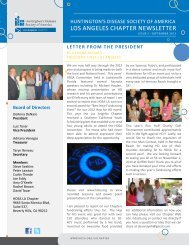Understanding Behavior in HD.final.8-18-05 - Huntington's Disease ...
Understanding Behavior in HD.final.8-18-05 - Huntington's Disease ...
Understanding Behavior in HD.final.8-18-05 - Huntington's Disease ...
You also want an ePaper? Increase the reach of your titles
YUMPU automatically turns print PDFs into web optimized ePapers that Google loves.
14<br />
STEP 3: Review possible causes of behaviors <strong>in</strong>clud<strong>in</strong>g bra<strong>in</strong> changes, environmental causes, <strong>in</strong>dividual<br />
contributions and health-related considerations. Evaluate any communication or triggers that might have<br />
caused the behavior.<br />
STEP 4: Set a realistic goal—one that you have a chance of achiev<strong>in</strong>g. Develop a list of possible responses to<br />
the behavior and prioritize them. Try environmental changes and try to change your own behavior.<br />
STEP 5: Be flexible and ready to try several strategies. Allow yourself several attempts and adequate time to use a<br />
trial and error process. Sometimes the best strategy may be time.<br />
STEP 6: Reassure all <strong>in</strong>dividuals <strong>in</strong>volved after a stressful event that you care and are try<strong>in</strong>g to understand<br />
how to make th<strong>in</strong>gs better. Don’t carry the burden alone. Ask for help, advice, assistance, and support. <strong>HD</strong> is a<br />
multidiscipl<strong>in</strong>ary, multigenerational disease. Use every friend, family member, and professional to assist <strong>in</strong><br />
mak<strong>in</strong>g your life and the life of the patient with <strong>HD</strong> as pleasant as possible.<br />
APPROACHES TO GOOD COMMUNICATION<br />
SKILLS OF COMMUNICATING<br />
• Be calm, gentle, matter-of-fact and relaxed.<br />
• Use humor or gentle teas<strong>in</strong>g. Conv<strong>in</strong>c<strong>in</strong>g someone to get out of bed or go to the bathroom is usually easier<br />
if you can make a game or joke of it. Use touch to show that you care, even when your words don’t show it<br />
or when they are not understood. Some people may shy away from contact, but most f<strong>in</strong>d a gentle touch<br />
reassur<strong>in</strong>g.<br />
• Start the communication socially. Trust is more easily established if you practice a<br />
balance of gett<strong>in</strong>g the task accomplished and chatt<strong>in</strong>g. Try spend<strong>in</strong>g a<br />
few m<strong>in</strong>utes talk<strong>in</strong>g about the ball game, the school activity, family<br />
members, a movie, the family pet or even the weather.<br />
• Use good eye contact and try to be at eye level. Keep your energy focused<br />
upon the <strong>in</strong>dividual.<br />
• Keep the rate, pitch and volume of your speech steady and low. Lower pitch<br />
and conversational tone are easier to hear.<br />
• If you are both gett<strong>in</strong>g frustrated, it may be a good idea to drop it and try aga<strong>in</strong> later. Sometimes a hug and<br />
a change of subject can make you both feel better. Other times you may need to leave the room and calm<br />
down.<br />
• Never give up. Even when communication is difficult, set up a signall<strong>in</strong>g system that will allow the person<br />
with <strong>HD</strong> to communicate nonverbally. Make flashcards of specific objects to which they can po<strong>in</strong>t.

















